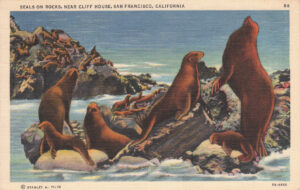“Can you tell I’m Asian when I’m wearing my sunglasses?” I asked my husband.
The searing July sun beat down as we hiked through Custer State Park, in South Dakota’s Black Hills, but I didn’t put the glasses on to protect from the glare. I put them on to protect from the stares.
I’ve lived in the Bay Area for nearly 20 years and, as a Korean American woman, I’ve mostly blended into a diverse demographic. That’s not to suggest racism isn’t also rooted in our liberal left coast bubble, but I don’t recall the reality of my mere existence eliciting blatant shock from strangers either.
When I saw the hard stares from White hikers on my climb through the Black Hills—lands the Sioux once called home, land now named after a general famous for their slaughter—that all too familiar feeling of “being different” came roaring back. And so too did my need for self-preservation, manifested, in this case, by hiding my slanted eyes. I put on the sunglasses. The stares stopped.
At the time, I didn’t feel angry. I didn’t find it weird. The discomfort felt…familiar. Growing up in the Chicago suburbs, the youngest daughter of immigrant parents, I was conditioned to accept marginalization through countless daily slights. In elementary school, my classmates would ask in disdain, “What’s a Korean?” People snickered and taunted when my parents communicated in broken English. It was my nine-year-old resident alien sister, So Young, who spoke the best English in our family and registered me for first grade. When friends would come over to our house, they’d tell me the smells of garlic and pickled everything—traditional foods in a Korean kitchen—were “weird,” so playdates rarely took place in the Kim household.
These experiences taught me to reject not just my Korean identity, but many of the ways society has tried to define me. I earned a BFA in printmaking, but I’ve never fit in the traditional art world. I received a master’s certificate in science illustration, but don’t work in academia. I created Ink Dwell, an art studio dedicated to exploring the wonders of the natural world, because I refused to place myself in prepackaged boxes created for me by other people. Nature, on the other hand, was the one place I did find community and comfort. I’ve never learned about a system or process in nature and thought to myself, “That just doesn’t make any sense.” In fact, learning about nature helps me make sense of the human-made world.
Diversity is fundamental to every healthy and productive ecosystem. A redwood forest didn’t develop by itself. It isn’t even as simple as a bunch of seeds getting buried and watered. The world’s largest trees reach such heights due to a complex interplay between countless species and environmental processes that create conditions suitable to produce the world’s most spectacular forests. A healthy coral reef is a riot of color and behavior brought to bloom by everything from microscopic plankton to sharks the size of Volkswagens. Nature teaches us that monoculture and uniformity destabilize a perfectly orchestrated symphony in which every species plays a critical part.
Despite my best efforts to contextualize myself through nature’s wisdom, I’ve found it impossible to avoid society’s imposed labels. In a twisted form of racial Stockholm syndrome, I have, through the years, taken solace that prejudice has at least painted me as the model minority: smart, docile, hardworking, nonthreatening. I was happy to be a house sparrow. In the parlance of species conservation, we Asian Americans are the “nonnative” of “least concern.” Those with darker skin tones are the “dangerous” and “endangered.”
So when I have experienced casual racism—a flippant comment, a hostile look, or the inevitability that while I’m creating a public art installation, passersby will assume one of my White assistants (or an absentee male boss) is responsible for the work—I comfort myself with the notion that these are comparatively gentle slights. I could have it much worse. My parents came here willingly, not in chains. They were promised freedom in a land of opportunity; they didn’t have their land stolen by invaders.
Over the years, I’ve felt outrage about racism perpetrated toward other peoples of color. But when I first heard about the murders of eight people, including six Asian American women, in several Atlanta-area massage parlors by a White evangelical Christian on March 16, 2021, my initial reaction was to try to shrug it off. “Well, this is America,” I told myself. “I’m surprised it took this long.”
It was only when my friends and family started reaching out to me, asking how I was feeling, if I was OK, that I began to understand that no, I was not OK. I was never OK. The Atlanta attack turned a spotlight on bigotries both old and new: the fetishization and sexualization of Asian women, and Covid-era violence toward Asian Americans—particularly and insidiously toward the elderly—as if we were somehow responsible for a virus that Trump called the “Chinese virus” and “kung flu.”
Despite my quiet justifications, there is nothing gentle about bigotry. My willingness to let small slights pass without challenge reflects society’s broader acceptance of this kind of damaging behavior. If we are to have hope of achieving an equitable future for all, both attitudes will have to change.
So I have made a promise to myself. No more house sparrow. I will no longer dismiss hurtful comments or actions with a laugh and a smile. True strength is not measured by my ability to absorb intolerance but in my efforts to confront, challenge, and change it.




